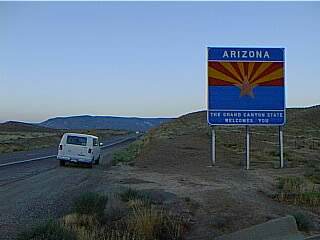

Home - Clean & Back - Day 22
"Clean Across America And Back" ended today as it began: quietly, with lots of desert drifting and some hill climbing in hot weather (after going over the Rockies a few days back, I'll never think of the Chiriaco Climb and other "humps" of less than a mile elevation change as "mountains"!). I hit the road just about at dawn, and clipped the northwest corner of Arizona for about 30 miles before entering Nevada.


My first refueling stop was in North Las Vegas, NV, at a FleetStar unmanned refueling station. Yes, my fuel card did work there; it's only in Texas that I needed a different FleetStar card, as I found out in Ft. Worth! On my way back to I-15 I decided to take a detour down Las Vegas Blvd., and all I can say is that it's a dangerous drive! Not that you're going to go off a switchback or get carjacked or something--it's just that there's so much to rubberneck at that it's hard to keep your eyes on the road. There are a lot of things there about which I could say something of the form "I never before saw (something) that was as (adjective) as that at (place) on the Strip"; for example, "I never before saw marquee lettering that was as big as that at Caesar's Palace on the Strip". Unfortunately there was no parking on the street, so I couldn't safely stop to take any photos; I'll have to go back there sometime and not just pass through. I'll add it to the list with Dayton, OH, and Milwaukee, WI, and Washington, DC, and lots of other places I had to "just pass through" on this trip...
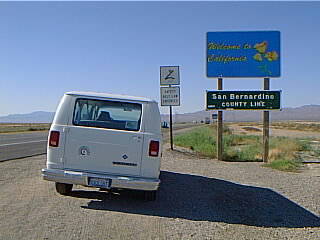
Late in the morning I re-entered California, heading south on I-15 to San Bernardino. There was one last set of hills to ascend and descend, and as I rounded the final bend I was reminded of why I have stuck with this whole alternative-fuels gig: the air was thick with smog in the valley below. As you look from one ridge of the foothills to the next farther one, you can see the farther one looking noticeably more washed-out by the extra thickness of smoggy air between you and it. I refueled at the San Bernardino County Yards, where some Long Beach Police Department vans were also refueling; they were taking an Explorer troop up to Big Bear Lake. Chalk that up as one more difficult trip that natural-gas vehicles can reliably make (they'd done it before); it's a climb of over a mile, and it's steep (I incinerated at least two sets of brakes on my old Chevy when I worked at the solar observatory there in summer 1986). And those Explorers, like everyone else who comes down that mountain, are going to get a good view of the smoggy air they live in as they drive home; I hope they are aware that by riding in those natural-gas vans, they are contributing a lot less to that problem than they otherwise would!
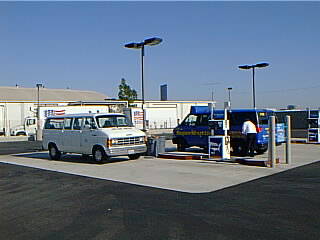
I continued back to Los Angeles, and the smog only got thicker. There isn't any horizon in some directions: the mountains just become invisible behind the haze when you look through more than several miles of it. I'm told I made about a twenty-fold improvement in my air quality by moving to the beach from the San Gabriel Valley, but there are plenty of folks who are stuck with that visible, sometimes tasteable air. I went to my usual refueling station in Torrance to conclude the trip, but as it happened it was out of order; as I have noted elsewhere, a viable regional alternative-fuels market includes enough stations that you can get to another one easily before running out of fuel, so I just drove to the station near my job, just outside Los Angeles International Airport (LAX), and tanked up there.
The Los Angeles Department of Airports is a stakeholder in the Los Angeles Clean Cities Coalition, and they have done a very good job of encouraging use of natural gas: the blue van across from mine in the photo is a door-to-door airport shuttle owned by SuperShuttle, who have replaced a large fraction of their fleet with natural-gas vans (that's a later version of my own 1993 Dodge, by the way); also, most if not all of the terminal-to-terminal and terminal-to-parking-lot buses run on natural gas.
I arrived back at my apartment, to find it pretty much as I had left it, i.e., a mess (hey, I'm a bachelor). I think I'll let some detailing pros get all the bugs and road tar off my van; if you multiply the frontal area of my van by the distance I traveled (8414 miles!), you find that I strained all the bugs out of a couple of billion cubic feet of air! Before updating this website for the last time on this journey, I fired up my Harley and rode her a few miles, just enough to blow the cobwebs out of her pipes and flush the stale gas from her carb (my old Chevy will need more extensive attention next weekend...). That's the first gasoline I've burned in three weeks; comparing the amount of fuel I use in a typical year in each of my vehicles, I think I'm about 90% to 95% petroleum free!
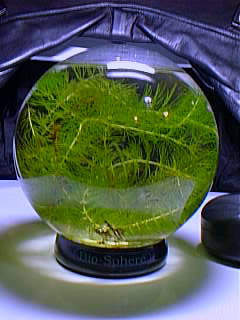
The object in the final photo above is my Bio-Sphere, a sealed glass sphere containing a complete aquatic ecosystem (plants, snails, small invertebrates...); it requires only a moderate temperature and a reasonable amount of light each day, which I provide while I'm away with a fluorescent lamp on a timer. It was in good shape, with plants and beasties healthy, when I returned, and if you will forgive me one final bit of moralizing, it serves as a pretty good illustration of why cleaner fuels need to become more common in the "outside world". We too live in a sealed biosphere, with nothing entering or leaving but radiant energy (light and heat), and any poisons we generate in our larger biosphere we have to live with. So here's hoping that we can reduce our output of those poisons! Replacing petroleum-based fuels with alternatives like natural gas can make a big contribution to that reduction, and I hope that by driving "Clean Across America And Back" I have helped to draw some attention to the fact that these alternatives are logistically and economically viable, and generally "ready for prime time". Thanks for coming along for the ride with me!
 Back
to "Clean Across America And Back"
Back
to "Clean Across America And Back"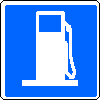 Back
to Fueling Station
Back
to Fueling Station Site
Map
Site
Map Contact
Me
Contact
Me All content copyright 1998-2024 by Mark Looper, except as noted. Reuse of my copyrighted material is authorized under Creative Commons Attribution 4.0 International license (CC BY 4.0).
![]()
![]()
new 23 August 1998